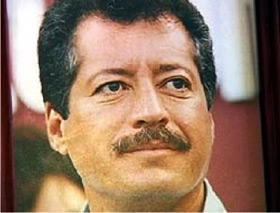 |
 |
 |
 News Around the Republic of Mexico | April 2005 News Around the Republic of Mexico | April 2005  
Colosio Foundation Exhibits Assassination Paintings
 Benedict Mander - The Herald Mexico Benedict Mander - The Herald Mexico


| | Luis Donaldo Colosio, presidential candidate for the Institutional Revolutionary Party (PRI). |
At 7:12 p.m. on March 23, 1994, Luis Donaldo Colosio, presidential candidate for the Institutional Revolutionary Party (PRI), was assassinated to the great shock and utter disbelief of the nation. For many, the victim's killers have never satisfactorily been identified, a fact which is alluded to in a series of intriguing paintings by Ilan Lieberman, now on show at the Fundación Colosio until May 23.

The exhibition, entitled "The Death of Colosio," opened at 7:12 p.m. on the anniversary of his death. It consists of five oil paintings in which the artist reproduces the exact moment when the shot was fired that ended the life of the much-loved PRI candidate for the 1994 presidential elections, subsequently won by his replacement, Ernesto Zedillo.

Lieberman paints the moment the shot rings out by pausing a video of the event. In five consecutive stages, the Mexican artist zooms closer into the action; but instead of somehow helping to solve the enigma and mystery which today still surround the event, all that results is a pixelated blur and the search for truth is ultimately frustrated.

Itala Schmelz, director of the Sala de Arte Público Siqueiros, observes that the work is an ironic reference to the 1966 film of acclaimed Italian director Michelangelo Antonioni, Blow-up, in which a fashion photographer discovers a murder by chance after blowing up a series of photographs taken randomly in a park.

"But unlike the fantastic findings of Antonioni's character, what happened on that 23rd of March is no better seen (or understood) on getting closer on the contrary, what you get is an image which is each time more indistinct," said Schmelz. "The pixels describe a color composition, not reality. How much of reality is contained in a representation? Perhaps by not being able to answer this, it may be that one can keep on and keep on painting," she added.

Jorge Moreno Collado, vice-president of the Fundación Colosio, further commented on the nature of Lieberman's work, which leads the viewer from the figurative to the abstract. "Painting is not necessarily a representation of reality, because it is often elusive, deceptive and multiple. As in these five canvases by Ilan Lieberman, The Death of Colosio becomes abstract, or it vanishes, because reality is always an interpretation," he said.

The image chosen by the artist carries further significance because it is one that is so deeply etched in the minds of Mexicans. That moment captured on television was repeated ad infinitum on national and international channels, effectively marking the birth of live television in Mexico.

"The work and its title reaffirm the certainty that those bullets and the assassination are not enough to kill [Colosio's] ideas and projects. And that the baseness of the crime is not powerful enough to destroy the greatness of a life of achievement abruptly cut short; that the sudden and fatal result of a gun shot is not capable of stopping the persistence of the work and projects of a man like Colosio, who we continue to remember with admiration," said Collado.

He observed that Lieberman's use of paradox and metaphor, not only in the paintings themselves but also in their title, confers a double meaning on the work, although "not for its mischievousness, not for the surprising interpretations provoked."

For many Mexicans, the identity of the perpetrator of the crime remains a mystery, not least for Rubén Aburto, the father of Mario Aburto who is carrying out a 45-year prison sentence for allegedly murdering Colosio.

"What we want is justice. My son did not kill him. He is innocent, they have used him as a scapegoat. I am convinced," he said in a March 2004 interview with Univision anchor Jorge Ramos. "Colosio was killed by the government, it was a crime by the state. Who else could have committed that crime?"

Benedict Mander is a freelance journalist living in Mexico City benedictmander@hotmail.com | 
 | |
 |



